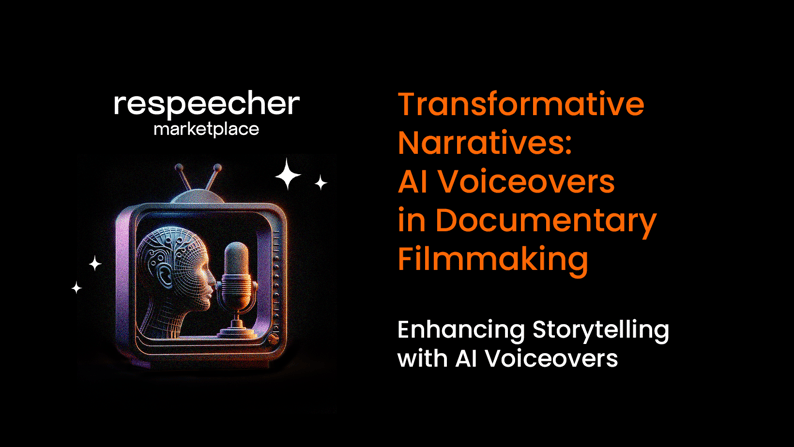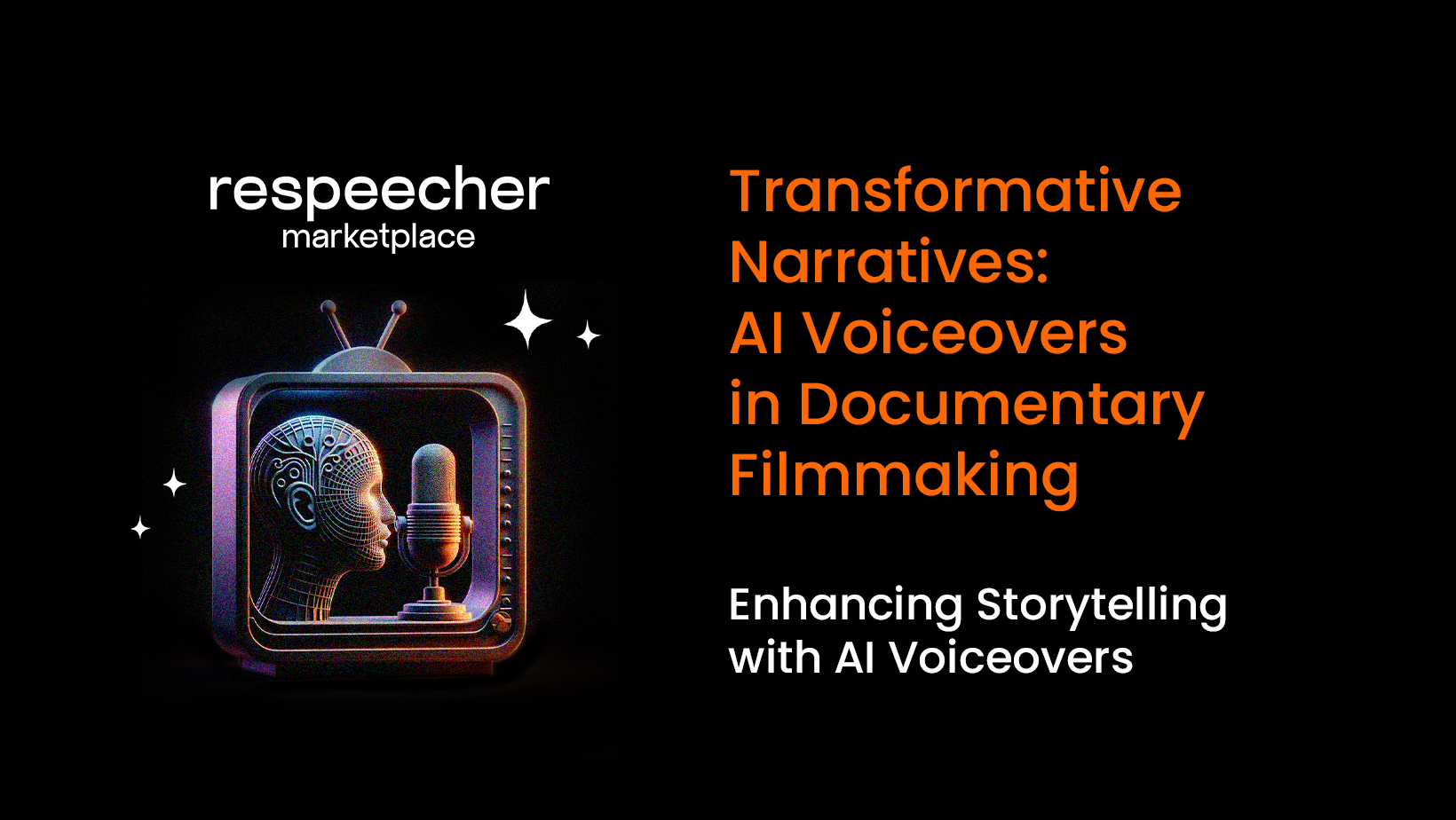Transformative Narratives: AI Voiceovers in Documentary Filmmaking

Voiceovers in documentary filmmaking and storytelling help to seamlessly weave narratives together and guide audiences. They enhance the viewing experience and convey complex messages with clarity and impact. The industry of voiceovers and audio production has been undergoing a profound transformation thanks to the emergence of AI voiceover technology. This cutting-edge innovation promises to revolutionize the industry by offering unprecedented speech synthesis and manipulation capabilities. Powered by advanced machine learning algorithms, AI voiceover technology can mimic the nuances of human speech with remarkable accuracy, creating highly realistic and customizable vocal performances.
The Evolution of Voiceovers in Documentary Filmmaking
Voiceovers have been an integral component of documentary filmmaking since the early days of cinema, serving as a narrative tool to convey information, evoke emotion, and guide audiences through the visual landscape of non-fiction storytelling. Traditionally, voiceover narration is recorded by professional voice artists or filmmakers, who needed to be physically present throughout the entire production process.
In the early years, voiceover narration was typically recorded in studio settings using analog recording equipment, requiring precise timing and coordination between the narrator and the film's visual elements. As filmmaking technologies progressed, so did the methods of recording and integrating voiceovers into documentaries, with filmmakers experimenting with different styles and approaches to enhance the storytelling experience.
Digital recording equipment, editing software, and AI voice generator technology have made capturing and creating voiceover narration easier and more cost-effective, allowing filmmakers greater flexibility and creative control over the final product. Now, they have tools such as an AI voice changer or a celebrity voice generator at their disposal (with proper consent and revenue sharing, of course).
“Digital recording equipment and editing software have made capturing and manipulating voiceover narration easier and more cost-effective, allowing filmmakers greater flexibility and creative control over the final product.”
AI Voiceover Technology: How It Works
AI voiceover technology offers unprecedented capabilities in speech synthesis and manipulation. At the heart of this innovation lies advanced machine learning algorithms enabling computers to mimic human speech nuances with remarkable accuracy.
Text-to-Speech Voice Synthesis
AI voiceover technology relies on sophisticated algorithms known as neural text-to-speech (TTS) models. These models are trained on vast amounts of audio data, including human speech recordings, to learn the intricacies of language, pronunciation, intonation, and emotion. By analyzing patterns in the data, the neural TTS models can generate highly realistic and natural-sounding speech in real time.
Speech-to-Speech Voice Synthesis
One of the key components of AI voiceover technology is the creation of AI-generated voices, also known as synthetic voices or digital voice clones. These voices are generated using deep learning techniques that involve training a neural network on a specific voice actor's recordings or a dataset of diverse voices. The neural network learns to mimic the unique vocal characteristics of the source material, allowing it to generate speech that closely resembles the original voice.
Creating and Customizing AI Voiceovers for Documentary Content
When creating AI voiceovers for documentary filmmaking, directors have several options for customization and adaptation to suit their specific needs:
- Voice Selection: Filmmakers can choose from various pre-trained AI-generated voices on Respeecher's Voice Marketplace or create custom voice clones based on specific criteria such as gender, age, accent, or language.
- Script Adaptation: AI voice generator technology allows for the seamless adaptation of scripts to fit the chosen voice, ensuring that the narration flows naturally and effectively communicates the intended message.
- Emotion and Tone: Advanced AI models can generate speech with varying degrees of emotion, tone, and emphasis, enabling filmmakers to convey the desired mood and atmosphere in their documentaries.
- Multilingual Capabilities: AI voice technology supports multilingual speech synthesis, allowing filmmakers to translate and localize their documentaries into multiple languages easily.
- Real-Time Editing: With AI-powered voiceover tools, filmmakers can make real-time adjustments to the pacing, pitch, and intonation of the narration, ensuring a polished and professional audio experience.
Enhancing Storytelling with AI Voiceovers
AI voice generator technology has emerged as a powerful tool for enhancing documentary storytelling, offering a range of benefits that empower filmmakers to create more immersive, accessible, and engaging content. Let's explore some of the key advantages of using AI voiceovers in documentary filmmaking and highlight examples of the effectiveness of this technology.
Versatility
Voice AI technology provides filmmakers unparalleled versatility in creating voiceovers that suit their documentaries' tone, style, and subject. Whether it's a solemn historical narrative, an upbeat travelogue, or a captivating wildlife documentary, AI-generated voices can be customized to convey the desired mood and atmosphere with precision and authenticity. It can also resurrect the voices of historical characters if you have the family’s permission to recreate the voice.
Cost-effectiveness
AI voiceovers offer a cost-effective alternative that reduces production expenses. Filmmakers can generate high-quality voiceovers using AI technology without a long recording process.
Multilingual Capabilities
One of the most significant advantages of AI voiceover technology is its ability to produce content in multiple languages easily. By leveraging advanced speech synthesis algorithms, filmmakers can translate and localize their documentaries into various languages, making them accessible to a global audience. Dubbing and localization not only enhance the reach and impact of the documentary but also foster cross-cultural understanding and appreciation.
Relevant Case Studies
Breathing Life into the Voice of Hawkwind's Robert Calvert. Envisioned by Graded Films, the "Mirror Mirror" project aimed to capture the essence of Robert Calvert, juxtaposing his legendary past with a present that longs for his voice. The ambition was grand – to create an audio-visual experience that would evoke nostalgia, admiration, and a fresh appreciation for Calvert's genius. The mandate for Respeecher was poignant: not just to emulate, but to revive Calvert's voice in its fullness, capturing its unique timbre and emotion. The goal was to create a sound that would touch hearts, especially those of Calvert’s fans and family.
A Collaboration to Bring a Toni Crews' Voice to Life in "My Dead Body". In 2022, Respeecher partnered with 141 Productions to recreate the voice of Toni Crews, a young woman who donated her body to science with permission for public display, leading to her being the focus of the film My Dead Body. The project challenged Respeecher to create a high-quality target voice model based on amateur recordings, as no professional recordings of Crews existed. This case study explores how Respeecher and 141 Productions overcame these challenges to bring Crews’ voice to life and pay tribute to her legacy.
Ethical and Creative Considerations
The emergence of AI voiceover technology has opened up new horizons for documentary filmmakers. However, ethical considerations must be carefully navigated to ensure responsible and respectful use of this powerful tool.
One of the primary ethical concerns surrounding using AI voiceovers in documentary filmmaking is the issue of consent. When utilizing AI to replicate or synthesize a human voice, filmmakers must consider whether the original voice actor or speaker has permitted their voice to be used in this manner. Without proper consent, the use of AI-generated voices could infringe upon the rights of individuals and raise questions about the authenticity and integrity of the storytelling process.
On the creative side, AI voice generator technology allows filmmakers to push the boundaries of storytelling and audio production. The ability to generate highly realistic and customizable voiceovers opens up new avenues for experimentation and innovation, allowing filmmakers to explore diverse narrative styles, perspectives, and voices that may not have been possible with traditional methods.
However, along with these creative opportunities come challenges and considerations. For example, reliance on AI dubbing could lead to a homogenization of voices in media, erasing the diversity of human speech and expression. Additionally, customizing and fine-tuning AI voiceovers requires technical expertise and resources, which may pose barriers for smaller or independent filmmakers with limited access to advanced AI tools and training.
Conclusion
The Global Documentary Film and TV Show Market is projected to grow at a CAGR of 5.8% from 2020 to 2027 to reach a market size of $21.5 billion by 2027. With AI voiceover technology, filmmakers can transcend linguistic and cultural barriers, reaching global audiences with compelling and immersive storytelling experiences. From enhancing multilingual accessibility to streamlining the production process, AI voice generator technology opens up new possibilities for experimentation and innovation, enabling filmmakers to push the boundaries of narrative expression in documentary filmmaking.
Still, filmmakers need to approach this technology with a commitment to ethical practice. To learn more about how you can use the potential of AI voiceovers for your documentary films, we invite you to explore the Voice Marketplace. Here, you can discover a diverse range of AI-generated voices and access the tools and resources you need to create customized and immersive audio experiences for your audience.
FAQ
AI voiceover technology uses speech synthesis and machine learning to generate realistic, customizable voiceovers. It allows filmmakers to create AI-generated voices, enabling voiceovers for documentaries, AI dubbing for films, and more, with enhanced precision and emotion.
AI voiceover technology offers customizable voiceovers for documentaries, ensuring perfect tone, emotion, and pace. It enables multilingual voice synthesis, making global storytelling more accessible and cost-effective, enhancing narrative clarity, and emotional impact.
Yes, AI voiceover technology can replicate emotions and tone with speech synthesis. Advanced models generate nuanced, dynamic speech, allowing AI voiceovers to convey feelings and moods, creating a powerful connection with audiences in documentaries and films.
Ethical concerns include obtaining consent for replicating voices and ensuring ethical voice AI use. Filmmakers must respect copyright, transparency, and avoid misrepresenting voices, ensuring authenticity and integrity in AI voice synthesis.
Respeecher's Voice Marketplace provides access to AI voice generators offering customizable voiceovers. Filmmakers can select AI-generated voices, adapt scripts, and utilize multilingual voice synthesis, enhancing creative flexibility and streamlining production processes.
Glossary
AI voiceover technology
Respeecher Voice Marketplace
Speech synthesis
Multilingual dubbing
Ethical AI practices






